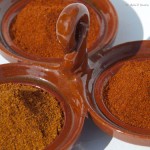
What is it?
- a red spice which adds a characteristic smoky flavour to Spanish cooking- paella and chorizo wouldn’t taste the same without it!
- it gives an orangey red colour to food.
- the powder is made from red chili peppers (capsicum anuum) which were traditionally dried in the sun or over wood fires for their smoky flavour. The peppers are called Ñora and Choricero.
- Nowadays modern mechanisation has increasingly taken over from traditional methods.

Dried Ñora Peppers
- Hungarian paprika is similar in look and taste although milder.
Cooking and Buying guide
There are three main flavour varieties:
- Dulce: (sweet) the mildest type and perfect for adding smoky flavour to your cooking.
- Agridulce: adds a medium hot, bitter-sweet flavour.
- Picante: as the name suggests, is hot and fiery.
The majority are produced in the Vera and Murcia regions of Spain. A DO stamp on the label denotes quality and the area it’s made in. (DO=Denominación Origen in Spanish.)
Cooking suggestions:
- a store cupboard essential, it can be used to pep up the most ordinary of dishes such as roast potatoes, tomato sauces, stews or rubbed onto fish, chicken or meat before cooking.
- For barbeques, stir pimentón into a little hot water to form a smooth paste and rub onto meat once it’s almost cooked, then return to grill, taking care not to burn the pimentón, or it will taste bitter.
- as with all spices, a little goes a long way!
Typical Spanish dishes which are characterised by the Pimentón flavour include: Patatas Bravas, Pinchitos de carne (similar to meat kebabs), Gambas al ajillo (Garlic Prawns.) and bean stews, such as Fabada.
Did you know?
Christopher Columbus accidentally discovered the chili peppers used to make pimentón. On his quest for black pepper from India (called pimienta in Spanish), he got lost and landed in the Americas. There he chanced upon a different kind of pepper which he took back to Spain as pimiento. The milled pimiento became a popular spice in Spanish cooking and over the years the name evolved to become pimentón.

You must be logged in to post a comment.